Kawasaki Z1000 2010
Kawasaki Z1000
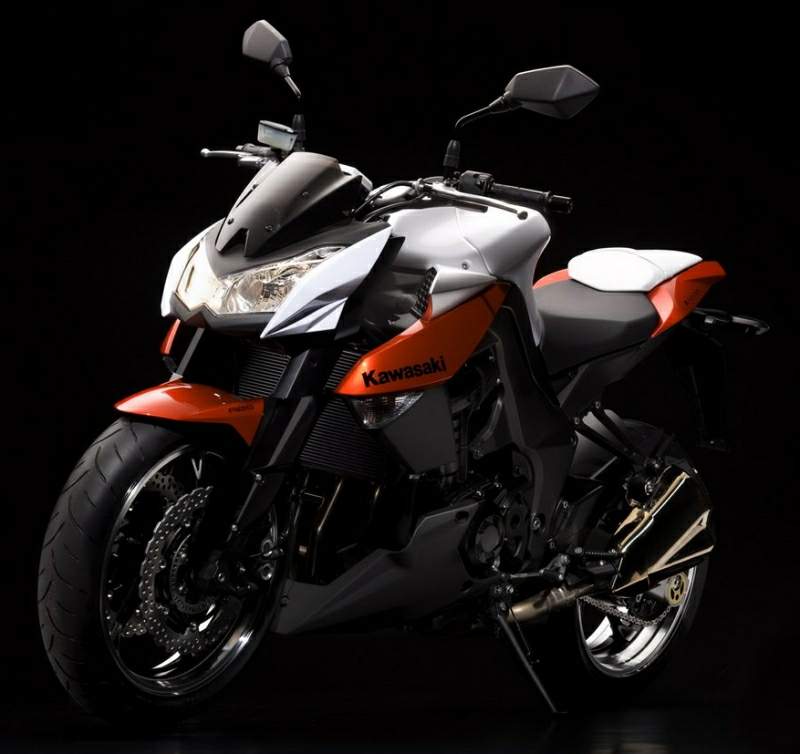
| Make Model | Kawasaki Z 1000 |
| Year | 2010 |
| Engine | Four stroke, transverse four cylinder, DOHC, 4 valve per cylinder. |
| Capacity | 1043 cc / 63.7 cu-in |
| Bore x Stroke | 77.0 x 56.0mm |
| Cooling System | Liquid cooled |
| Compression Ratio | 11.8:1 |
| Lubrication | Wet sump |
| Engine Oil | Synthetic, 10W/40 |
| Induction | DFI� with four 38mm Keihin throttle bodies, oval sub-throttles |
| Ignition | TCBI with digital advance |
| Spark Plug | NGK, CR9EK |
| Starting | Electric |
| Max Power | 101.5 kW / 138 hp @ 9600 rpm |
| Max Torque | 110 Nm / 1.2 kg-fm @ 7800 rpm |
| Clutch | Wet, multiple discs, cable operated |
| Transmission | 6 Speed |
| Final Drive | Chain |
| Gear Ratio | 1st 2.600 (39/15) 2nd 1.950 (39/20) 3rd 1.600 (24/15) 4th 1.389 (25/18) 5th 1.238 (26/21) 6th 1.136 (25/22) |
| Frame | Type: Aluminum Backbone |
| Front Suspension | 41mm inverted cartridge fork with stepless compression and rebound damping, adjustable spring preload |
| Front Wheel Travel | 120 mm / 4.7 in |
| Rear Suspension | Horizontal monoshock with stepless rebound damping, adjustable spring preload |
| Rear Wheel Travel | 135 mm / 5.4 in |
| Front Brakes | 2x 300mm 4 piston calipers |
| Rear Brakes | Single 292mm disc 2 piston caliper |
| Front Tyre | 120/70 R17 |
| Rear Tyre | 190/50 R17 |
| Rake | 25� |
| Trail | 102 mm / 4.0 in |
| Dimension | Length 2080 mm / 81.9 in Width 770 mm / 30.3 in Height 1055 mm / 41.5 in |
| Wheelbase | 1420 mm / 55.9 in |
| Seat Height | 815.3 mm / 32.1 in. |
| Ground Clearance | 145 mm / 5.7 in |
| Dry Weight | 198 kg / 436.5 lbs |
| Wet Weight | 221 kg / 487.2 lbs |
| Fuel Capacity | 18 Litres / 4.8 US gal |
| Consumption average | 17.1 km/lit |
| Standing � Mile | 11.1 sec |
| Top Speed | 239.7 km/h / 148.9 mph |
Kawasaki Z: Bringing You the World�s Coolest Streetbikes Since 1973 With this latest in a long line of naked Kawasaki streetbikes, we threw out the old rules and started with a clean sheet, drawing upon more than 35 years of experience in giving the people what they want. If the new Z1000 knocks your eyeballs out, that�s exactly what we had in mind. Even more important, though, is the feeling this one provides every time you twist the throttle.
A sharp new front cowl sloped back at an acute angle highlights the Z1000�s new nose, followed by a tilting instrument panel, visible through an orange lens, that can be angled to suit rider preference. Just below that a long, narrow headlight represents Kawasaki�s first use of a line-beam unit. Following the lines rearward, the eyes will next encounter a dynamically designed steel gas tank, flared on the sides to let you grab it with your knees, and trim at the rear for a snug fit. The seat�s low and narrow at the front to make ground contact easy, and it flows beautifully rearward to end in a futuristically retro LED taillight behind a red lens.
Previous Z1000s used a steel frame, but this one gets its own all-new aluminum one. Similar in concept to the frame of the Ninja� ZX�-10R sportbike, the frame beams curve over the engine, resulting in a narrow bike that�s easy to grip with the knees. The engine bolts in solidly, stressed-member style, at three places, and in a rubber mount at the upper rear of the crankcase for great torsional rigidity and solid handling. Wherever possible, welds were eliminated for a smooth, organic appearance. The main frame and swingarm pivot areas, for example, are cast as a single unit. The rear subframe is a three-piece aluminum die-casting, light, smooth and beautiful.
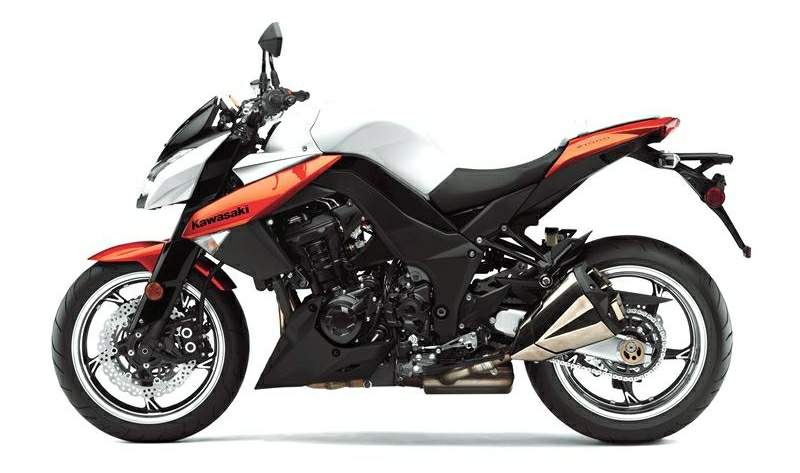
At the heart of every naked bike is its engine. We didn�t just bolt it into that frame for solid handling, we did it so you won�t forget what you�re riding: You�ll definitely feel those 1,043 cubic centimeters of fuel-injected Kawasaki four-cylinder every time you twist the throttle. A secondary balance shaft eliminates excess vibes, but on this bike, a little bit of character is designed in. In the same spirit, the bike�s cool air system uses ducts just ahead of the fuel tank to usher air into the airbox, a placement that lets the rider savor the bold sound of screaming air being sucked into the engine�s downdraft intakes.
The Z1000�s four-cylinder uses a longish stroke�56mm�to make the most impact in the rpm range most used by naked bike riders. Long-stroke engines keep intake air velocity up for maximum midrange power whatever the displacement. From nearly any rpm, rolling the Z1000�s throttle open provides the kind of instant gratification most sportbikes just can�t quite muster. Having said that, this engine also spins up noticeably faster from about 7000 rpm upwards, with a silky smooth, highly intoxicating response.
What more do you need? Not much. How about new five-spoke wheels, with spokes machined near the rims for a custom-wheel look. We carried forward the quad-pipe theme from the last Z1000 (and the first Z1), but an under-engine pre chamber let the engineers use shorter mufflers for great looks, better mass centralization and light, quick handling. A solid-mount handlebar and aluminum footpegs lifted from the Ninja ZX-10R complete with machined edges contribute to the Z1000�s direct feel.
Nobody scrimped on the suspension and running gear, either: A radial-pump master cylinder provides the latest in braking feel and feedback. Adding compression damping adjustability to the 41mm inverted fork gives it all-way tunability, and a completely new, horizontal placement of the rear shock provides typically UNI-TRAK�-like performance.
The next time somebody complains to you that modern motorcycles have no soul, take them for a ride on a new Z1000. Everything about it is up-to-the-minute modern. But you can feel its roots every time you hit the starter. This one�s classic Kawasaki all the way.
Development of the new 2010 Z1000 started from scratch, with the specific goals of creating a distinctive visual impact and superior on-road performance. The end result is essentially a custom-made super streetfighter.
A unique blend of Japanese art and technology, the 2010 Z1000�s styling takes a dramatic leap forward with the distinct look of an apex predator. Hunched-down and ready to pounce, its visual impact is much stronger than that of a naked sportbike, or a derivative copy of some Euro trend.
The Z1000 clearly surpasses the dynamic performance of its predecessors, thanks to a new quick-revving 1,043cc inline-four cylinder engine, and an all-new quick-steering aluminium chassis connected to an all-new horizontal rear suspension design. Though it offers true sportbike handling; the Z1000�s comfortable, upright riding position mean it remains a practical transportation tool, even as the dramatic howl from its new cold-air intake raises hairs on the back of its rider�s neck.
Authentic Kawasaki Accessories are available through Kawasaki dealers.
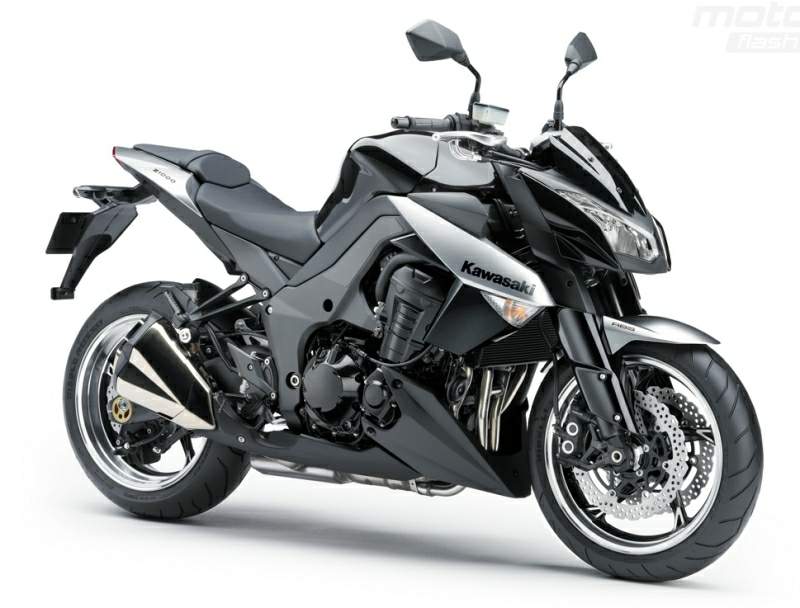
Features and Benefits:
All-new Engine
- Liquid-cooled, DOHC, 16-valve 1,043cc inline-four offers greater torque and a stronger top-end rush than previous Z1000 models
- Bore and stroke of 77.0 x 56.0 mm were chosen to achieve the desired engine character -strong in the everyday rpm range most used by naked super bikes
- 38mm downdraft throttle bodies allow intake air to travel to the engine in the shortest possible distance
- Oval sub-throttles help keep the engine slim - a good thing since the throttle bodies are positioned between the rider's knees
- Soft rev limiter provides good overrev; power doesn't drop off suddenly at high rpm
- Crankshaft and transmission shafts are arranged in a straight line instead of a triangular layout, to maintain the design from the previous Z1000 - a design that offers the best look for a naked model
- The crankshaft was lowered to allow for a longer stroke without adding engine height
- A secondary balancer, driven off a gear on the sixth web of the crankshaft, eliminates excess vibration
Cool Air System
- The intake system routes cool air to the airbox from ducts above the radiator shrouds, minimizing performance loss due to heated intake air
- Positioning the ducts close to the rider allows the intake sound to be enjoyed by the rider
- A resonator inside the airbox reduces noise at low rpm, and enhances intake sound at high rpm
Exhaust System
- The exhaust system features a 4-into-2-pre-chamber-into-2 layout. Silencer end-caps maintain the quad-style image
- Main and pre-catalyzers ensure emissions are clean
- Thanks to the under-engine pre-chamber, silencer volume could be reduced. The silencers are also lighter. Overall exhaust system weight is about the same, but the new system offers much better mass centralization and contributes to a lower center of gravity
Fuel Pump
- Slim-type fuel pump features an integral fuel gauge
- With revised fuel tank design and the slim-type fuel pump, dead volume inside the tank is minimized; fuel capacity is 4.1 gallons
All-New Aluminum Backbone Frame
- An aluminum backbone frame designed specifically for the Z1000, and similar in concept to the frame of the Ninja ZX-10R, allows a narrow construction that is easy to grip with the knees
- Lightweight and highly rigid, the frame uses the engine as a stressed member, for a firm, planted feeling and enhanced stability
- Frame is tuned to transmit the ideal level of engine feedback directly to the rider
- The frame's five-piece construction consists of steering stem, left and right main frames, and two cross pieces. The two main frame components have open C-shaped cross sections
- As much as possible, welds were eliminated for simplicity and appearance. The frame beams and swingarm brackets are now single die-cast pieces
- The new frame uses four engine mounts; three mounts are rigid, the upper rear crankcase mount is rubber
- The rear sub-frame is a three-piece aluminum die-casting construction, light, strong and good for mass centralization
- The sub-frame is an example of form and function combined, negating the need for side covers and allowing underseat narrowness for a shorter reach to the ground
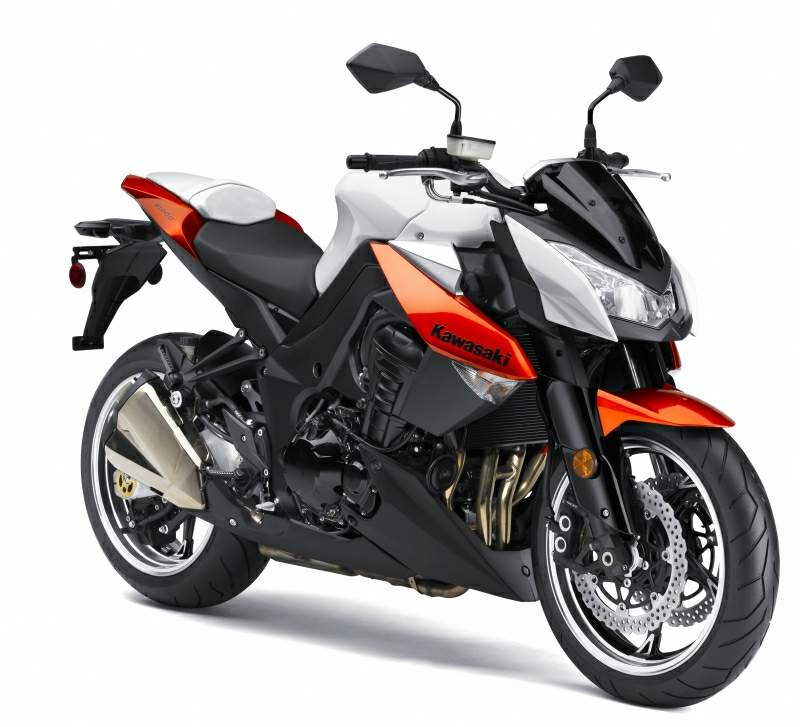
All-New Horizontal Rear Monoshock
- New rear suspension positions the shock unit and linkage above the swingarm where it's less exposed to exhaust heat and contributes to mass centralization
- Visible from the outside, the horizontal monoshock contributes to the aggressive appearance of the new Z1000
- Linkage characteristics are the same as those of a standard UNI-TRAK rear suspension: Wheel movement versus shock stroke is the same ratio
- The shock features rebound damping and spring preload adjustability
Fully Adjustable Front Fork
- The Z1000's 41mm inverted fork is adjustable for compression damping, rebound damping and spring preload - and it's protected from harm by a cool-looking shroud
- Settings are designed for both sporty back road performance and excellent comfort on the street
Handlebar, Grips and Footpegs
- The tubular handlebar is rigid-mounted, contributing to sharp, direct handling
- A wide, flat bend handlebar offers a design similar to those on off-road bikes, for excellent control
- Tapered-type grips, like those used on supersport models, offer more direct feel
- Ninja ZX-10R-style footpegs with knurling offer good grip, direct feel and control and no-nonsense looks
- The passenger footpeg brackets incorporate convenient luggage hooks
Brakes
- The Z1000's 300mm front petal brake discs are gripped by opposed four-piston radial-mount calipers. (Caliper piston size is 4x30 mm)
- A radial-pump front brake master cylinder contributes to the superb control and feel offered by the new calipers
- The rear brake is a single piston, pin-slide caliper gripping a 250mm petal disc. The caliper is mounted below the swingarm, and located by a torque rod
Instrumentation
- A distinctive tilting instrument panel with multifunction LCD display behind an orange lens covers all systems
Overview
TAILOR-MADE SUPER NAKED
In order to deliver an "excitement" never before experienced with Super Naked models,development of the new Z1000 started from scratch - essentially resulting in a Tailor-made Super Naked.
1. VISUAL IMPACT
Unlike the "mono-form" design of supersport models (where the ensemble is designed as a single piece), Kawasaki naked model designs are collections of parts - each meticulously crafted as both stand-alone components, and as parts of a whole. While contemporary Super Naked models are often no more than supersport models with the fairings removed, the new Z1000 realises a stunning VISUAL IMPACT by being conceived in complete design freedom.
Conceived in complete design freedom for a completely unique appearance.
Each part of the new Z1000 was meticulously designed with a dual role in mind:
Individual functionality, and realization of a condensed, mass-forward image.
While the 2007 Z1000 took the avant-garde design of its predecessor and made it sharper and more aggressive, both models can still be said to have conventional designs. In addition to individual functionality, each part of the 2010 Z1000 was designed to draw volume (and mass) away from extremities and toward the centre. The resultant condensed, mass-forward image gives the new Z1000 a more powerful, dynamic design.
2. RIDING IMPACT
Supersport-based engines and chassis offer high performance, but the number of riders who are able to enjoy this performance on the street is limited.
Rather than pursuing "speed" and performance figures, Z1000 development focused on the "excitement" derived from riding a sport bike on the street, thereby achieving a high RIDING IMPACT.
Ride with "IMPACT" at any time, in any situation
New engine: designed to offer increased feeling of "acceleration"
1,043 cc 16-valve DOHC In-line Four
Completely new engine.
Bore and Stroke chosen to achieve desired engine character.
Development Goals:
WILD engine character
Sharp throttle response
High-rpm Power and Sound of an In-line Four
Intoxicating intake howl care of new Cool Air system
Cool Air System
New system uses ducts to direct fresh (cool) air into the air cleaner. Positioning the ducts close to the rider allows the intake sound when accelerating to be enjoyed.
New chassis: designed to maximize enjoyment of sport riding on the street
Highly rigid aluminum frame delivers very direct feel
Rigidity of the main frame was increased; engine mounts increased from 3 to 4.
Using the engine as a stressed member contributes to direct handling.
Using lightweight aluminum for the frame (previously steel) contributes to sharp handling.
Slim, compact twin-tube frame design contributes to ergonomics.
Slim, compact backbone twin-tube frame design contributes to ergonomics
Uniting the main frame and swingarm pivot area contributes to high-quality finish. (welds eliminated)
Features for high level of control
Handlebar
- Wider and moved slightly further and higher. New position contributes to the rider's freedom of movement.
- Fat-type handlebar contributes to tough appearance.
Seat height
- Lowered approximately 5 mm. Slightly narrower thanks to the new frame; this contributes to the rider's freedom of movement.
Footpegs
- Aluminum footpegs from the Ninja ZX-10R with machined edges contribute to the direct feel.
Front brakes
- Radial-mount calipers and a radial-pump master cylinder deliver superb braking performance and precise brake control.
Front suspension with compression adjustability
- Compression damping adjustability added. Settings chosen to deliver light handling.
Thorough mass centralization contribute to light, sharp handling
KEY MASS-CENTRALIZING COMPONENTS
Short silencers & pre-chamber
Horizontal Back-link rear suspension
Downdraft throttle bodies
Aluminum rear frame
Ignition key cylinder
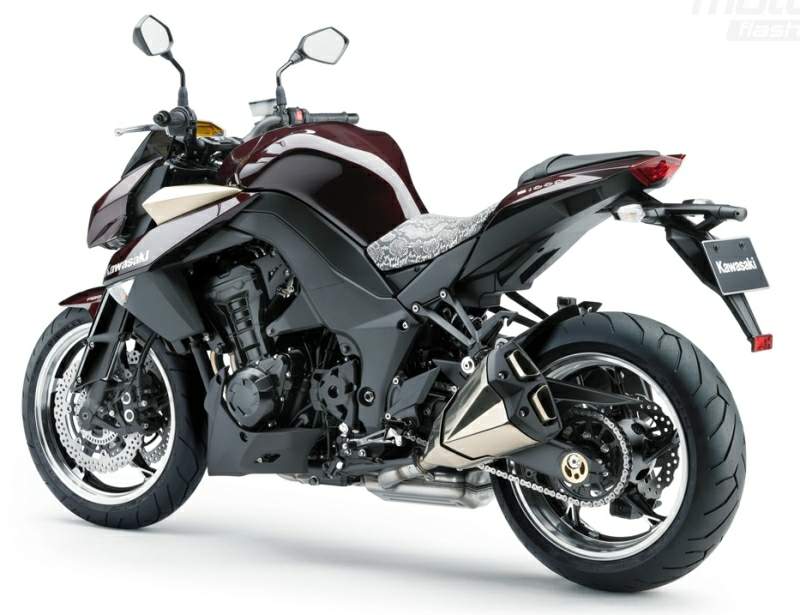
Chassis
VISUAL IMPACT
The new Z1000 takes the aggressive styling of its predecessor a step forward. From the sharply sloped front cowl design made possible with the slim new line-beam headlamp, to the minimalist tail section, the new Z1000 presents a very condensed, mass-forward image. This dynamic design is reinforced by the front fork covers and wide shrouds adorned with intakes for the new Cool Air system. Where its predecessor formed the image of an athlete poised to explode out of the blocks, the new Z1000 gives the appearance of a dangerous predator feigning sleep - though no less ready to leap forward without a moment's hesitation.
Condensed, Mass-forward Image for Dynamic Design
Sharp front cowl slopes back at an acute angle, contributing to the aggressive design and the image of a low, forward-located centre of gravity.
In addition to protecting the inverted fork's inner tubes, fork covers reinforce the low, mass-forward image.
Slim, compact line-beam type headlamp (first use on a Kawasaki) allowed the design freedom to make the front cowl smaller. Locating the bulbs slightly higher in the headlamp unit gives the Z1000 a fierce look when viewed from the front.
Ignition key cylinder was relocated to the front of the tank (previously forward of the handlebar), allowing the instrument panel to be positioned closer to the rider for enhanced visibility. Relocating the key cylinder away from the instrument panel also helped make possible the compact front cowl. Moving the key cylinder closer to the rider also contributes to mass centralization.
Dynamic fuel tank design features supersport-style flared edges with a trim shape at the rear, a shape that is easy to grip with the knees. Concentrating the tank's volume toward the rear helped make room for the repositioned key cylinder. Steel construction facilitates the use of magnetic tank bags.
Voluminous shrouds with integrated turn signals contribute to the new Z1000's concentrated, massforward design.
Sharp under-cowl adds to the image of a low centre of gravity and reinforces the mass-forward design.
Minimalist tail cowl is slimmer and more compact, moving mass both physically and visually away from the rear and toward the front.
LED taillight design, reminiscent of the original Z1000's, features red LED bulbs and a transparent lens.
The silencers are also lighter (5,100 g >> 3,500 g each). While overall exhaust system weight is about the same when the prechamber is included, the new system offers much better mass centralization and contributes to a lower centre of gravity.
Quad-style muffler maintains a key design element from previous models. The silencers are also lighter (5,100 g >> 3,500 g each). While overall exhaust system weight is about the same when the prechamber is included, the new system offers much better mass centralization and contributes to a lower centre of gravity.
Tilting Instrument Panel
Fully digital instrument panel features an eye-catching orange lens .
The instrument panel can be angled to suit rider preference. Riders can choose from three positions. Angle can easily be changed without tools using an adjuster knob on the left side.
Meter functions include digital speedometer, bar-style digital tachometer, odometer, two trip meters, fuel gauge, and clock.
Details
Swingarm features eccentric axle adjusters, contributing to the Z1000's Kawasaki identity.
Unnecessary material trimmed from the rear flap to give it a light look.
RIDING IMPACT: CHASSIS
To deliver a high riding impact, Kawasaki engineers wanted a quick-steering and lighthandling package. An all-new aluminum frame with 30% more rigidity, increased mass centralization, using the engine as a stressed member, and a new rigid-mount handlebar all contribute to sharper, firmer handling. A new tank and sub-frame offer a slim riding position, and a number of other changes offer increased control.
All-new Aluminum Twin-tube Frame
Highly rigid aluminum frame delivers very direct feel Similar in concept to the frame of the Ninja ZX-10R, the frame beams go over the engine (on a supersport model the frame beams would be much stiffer), allowing a narrow construction that is easy to grip with the knees.
Lightweight and highly rigid, the frame uses the engine as a stressed member. Torsional rigidity is up about 30%; lateral stiffness is about the same. The frame itself is approximately 3-4 kg lighter.
Handling is improved, offering a firmer, more planted feeling, and stability is enhanced. The new frame offers firmer handling and enhanced stability.
The frame beams and swingarm brackets are now single die-cast pieces. The new frame is a 5-piece construction, consisting of steering stem, left and right main frames, and two cross pieces. The two main frame components have open C-shaped cross sections.
As much as possible welds were eliminated, offering an improved appearance.
The new frame uses 4 (instead of 3) engine mounts. All engine mounts are rigid except the upper rear crankcase mount, which is rubber. The increased rigidity (also due to using the engine as a stressed member) contributes to lighter, firmer handling while maintaining stability.
Feeling from the engine is also transmitted more directly to the rider.
The rear sub-frame, previously two steel pieces (left/right) welded to the frame, is now a 3-piece aluminium die-cast construction. The new sub-frame weighs less, contributing to mass centralization.
The sub-frame is an example of form and function combined, allowing the side covers to be eliminated. This also allows the width under the seat to be narrower, offering riders a shorter reach to the ground.
Mass Centralization
The new exhaust system (with shorter silencers and pre-chamber), Horizontal Back-link rear suspension and the use of downdraft throttle bodies are the greatest contributors to mass centralization.
The new aluminum sub-frame and repositioned key cylinder also contribute. The result is lighter, sharper handling. Turn-in is light. Steering is neutral after the bike has been leaned over. The bike is stable mid-corner. And the bike goes where you want it to.
Fully Adjustable Front Fork
With the addition of compression damping adjustability, the Z1000's 41 mm inverted front fork is now fully adjustable.
Settings offer both sporty performance (contributing to light handling on the street and in the hills) and comfort.
Fat-type Handlebar, Grips & Pegs
New handlebar is rigid-mount, contributing to the sharper handling.
The handlebar is thicker at the centre (28.6 mm), tapering to 22.2 mm at the grips.
Revised position is slightly wider (23 mm), slightly further (14 mm) and slightly higher (7 mm). The revised position and a flatter bend offer a design similar to handlebars of off-road bikes, facilitating control.
The new handlebar also looks tough, contributing a touch of badboy image to the Z1000's appearance.
Tapered-type handle grips (like those used on supersport models) offer more direct feel.
Ninja ZX-10R-style footpegs with knurling offer good grip, more direct feel and control, and also contribute to the sporty look.
Tandem footpeg-stays incorporate convenient luggage hook.
Front and Rear Seats
Seat height is approximately 5 mm lower, and the seat could be made slimmer thanks to the new subframe. The result is an easier reach to the ground.
Compact passenger seat matches the design of the Z1000's tail section.
Engine
RIDING IMPACT: ENGINE
To maximize impact, the engine needed to deliver more than just performance figures. Riding impact is about the sensation the rider feels. Engineers wanted to offer superb throttle response, power delivery with a hit in mid-range, and a seductive intake howl with just the right amount of engine vibration to make accelerating an exhilarating experience.
All-new Engine
Liquid-cooled, DOHC, 16-valve 1,043 cc In-line Four offers a greater power output (138 PS) and stronger torque than that of the previous Z1000. The new displacement was chosen with the desire to maintain the Z1000 name.
Bore and stroke of 77.0 x 56.0 mm were chosen to achieve the desired engine character. Compare this to the bore and stroke of the 2008 Z1000 and 2009 Ninja ZX-10R:
2008 Z1000 - 77.2 x 50.9 mm
2009 Ninja ZX-10R - 76.0 x 55.0 mm
1,043 cc 16-valve DOHC In-line Four
Downdraft throttle bodies allow intake air to travel to the engine in the shortest possible distance, offering improved performance. While downdraft throttle bodies often use short intake funnels to maximize high-rpm performance, the Z1000's are longer to offer the best Super Naked power characteristics.
Throttle bore is �38 mm (2008 Z1000 was �36 mm), chosen to offer the ideal low-mid range response.
Oval sub-throttles help keep the engine slim - this is important since the throttle bodies are now positioned between the rider's knees.
Good over-rev characteristics mean that power does not drop off suddenly at high rpm.
Engine tuning is focused on the feeling the rider gets when opening the throttle. There is a much greater feeling of torque (set at the maximum level before the rear wheel starts spinning). Get on the gas at any rpm and the engine pulls strongly - although the feeling is more like being propelled forward.
Power delivery is quite linear, but the engine spins up noticeably faster from about 7,000 rpm onwards. Silky smooth response from mid-high rpm ensures excellent driveability.
Crankshaft and transmission shafts are arranged in a straight line (compared to the Ninja ZX-10R, which uses a triangular layout). This maintains the design from the 2008 Z1000, an engine design we felt offers the best look for a Super Naked model.
Crankshaft was lowered to allow for the longer stroke without adding engine height. The shaft line, which was horizontal on the 2008 Z1000, is angled 5o down. Thus, engine size is about the same despite the 90 cc displacement increase.
A secondary balancer, driven off a gear on the 6th web of the crankshaft, eliminates excess vibration. Of course, a certain amount of engine vibration was desired as part of the bike's character (vibration contributes to the feeling of acceleration, increasing linearly with rpm), so vibration was not totally eliminated. However, adding the secondary balancer enabled the changes to the chassis for improved handling (With the chassis changes, the vibration transmitted to the rider is about the same as the 2008 Z1000)
Cool Air System
With the airbox nestled between the frame rails, intake air is more affected by engine heat.
The Cool Air system routes cool air to the airbox from ducts above the shrouds, minimizing performance loss due to heated intake air. This should not be confused with Ram Air, where force-fed air becomes pressurized in the airbox.
Positioning the ducts close to the rider allows the intake sound to be enjoyed by the rider.
A resonator inside the airbox reduces noise at low rpm, and enhances intake sound at high rpm.
Exhaust System
The exhaust system features a 4-into- 2-pre-chamber-into-2 layout. Silencer end-caps maintain the quadstyle image
Main and pre-catalysers ensure emissions are clean.
An exhaust device is located upstream of the right-side silencer.
Thanks to the under-engine prechamber, silencer volume was reduced from 4.5 Litres to 3 Litres each. The silencers are also lighter (5,100 g >> 3,500 g each). While overall exhaust system weight is about the same when the prechamber is included, the new system offers much better mass centralization and contributes to a lower centre of gravity.
Fuel Pump
Slim-type fuel pump features a unitised fuel gauge.
With the revised fuel tank design and the slim-type fuel pump, dead volume inside the tank is minimized.
2008 Z1000 - Total volume - 18.5 Litres - Usable volume - 17 Litres
2010 Z1000 - Total volume - 15.5 Litres - Usable volume - 15 Litres
Suspension
Horizontal Back-link rear suspension
This locates the suspension far enough from the exhaust that operation will not be affected by heat.
The new arrangement contributes to mass centralization.
Visible from the outside, the backlink Horizontal Back-link contributes to the appearance of the new Z1000.
The new rear suspension eliminates the external reservoir tank, however performance is the same or better than that of the 2008 Z1000.
Linkage characteristics are the same as those of a standard Uni-Trak rear suspension: linkage ratios were set such that rear wheel movement vs shock stroke is the same as would be with Uni-Trak rear suspension.
As before, the rear shock features rebound and preload adjustability.
Brakes & Tires
Brakes
At the front, the Z1000's 300 mm petal brake discs are gripped by opposed 4-piston radial-mount calipers. Caliper piston size is 30 mm.
Radial-pump front brake master cylinder also contributes to the superb control and feel offered by the new calipers.
Swingarm features eccentric axle adjusters, contributing to the Z1000's Kawasaki identity.
The caliper is mounted below the swingarm and features a torque rod. The arrangement adds a racy image.
Tires
New tires contribute to Z1000's nimble handling.
ZR1000D: Dunlop D210
Tire sizes are unchanged from its predecessor.
F: 120/70ZR17M/C (58W)
R: 190/50ZR17M/C (73W)
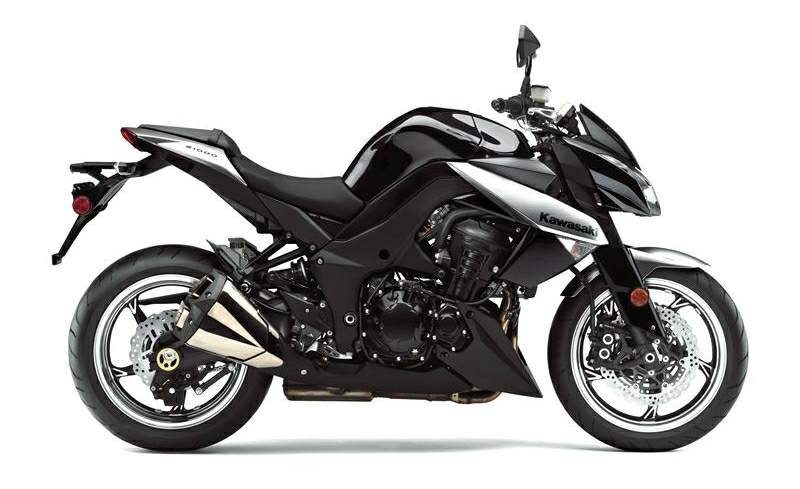
Source: https://www.motorcyclespecs.co.za/model/kawasaki/kawasaki_z1000%2010.htm


0 Komentar